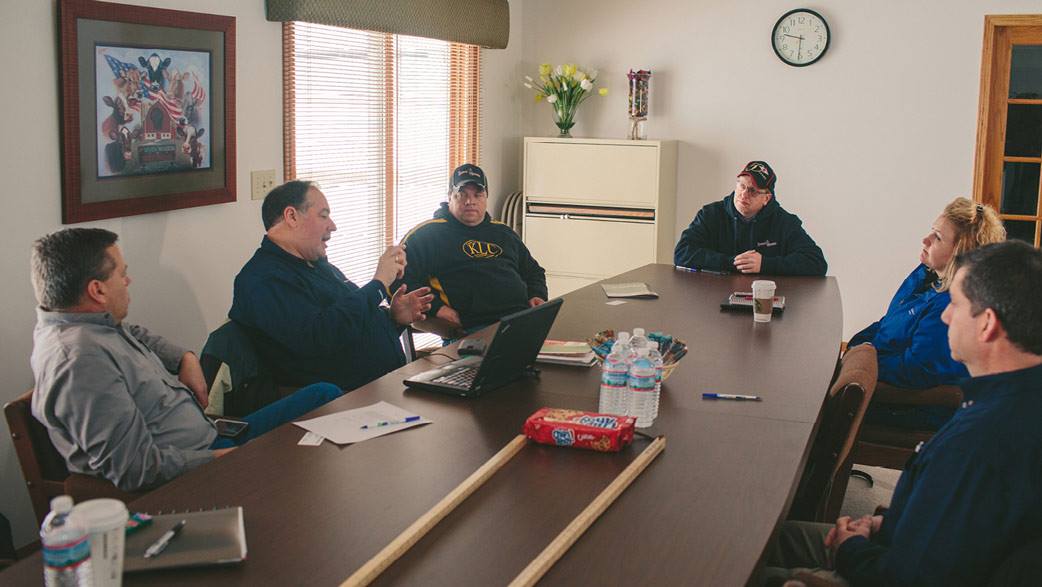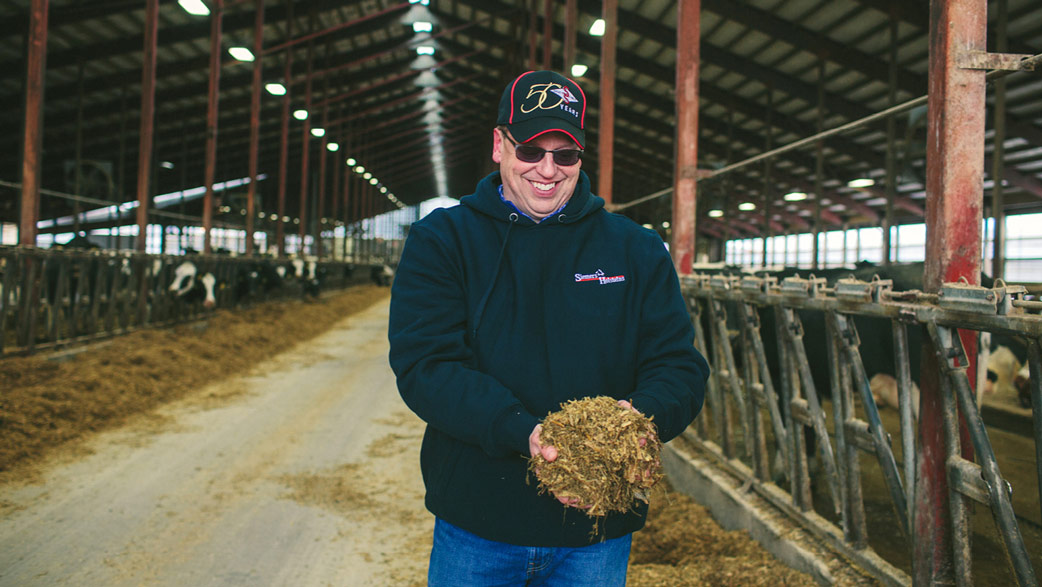At the head of a long, wooden table sit two business partners. On either side for the next 20 feet are a group of advisors and consultants throwing out words like productivity, efficiency and profitability.
While this may sound like your typical boardroom scene, the setting on this occasion is the main office of a modern family farm in Eastern Wisconsin. This is the new reality of family farming in which couples, siblings and parent-child partners make strategic decisions to maximize their resources and improve their productivity.
Today’s meeting includes Land O’Lakes, Inc. dairy member-owner Dan Siemers and his brother Paul, an agronomist from their local cooperative, a WinField forage expert and the team’s Land O’Lakes Master Dairy Advisor and sustainability expert. Even with the view of heavy snow falling in the window, the team is hard at work planning for the upcoming planting season while keeping an eye on many harvests to come.
To some, this may seem like overkill. But by taking a holistic approach to his dairy operation, Dan has developed a data-driven management system that increases productivity while simultaneously decreasing his environmental footprint and improving the overall health of his animals.

The system
At Siemers Holsteins, 2,400 cows produce about 85 million pounds of milk per year. Dan and his team also farm about 5,000 acres; what they grow is almost exclusively used as feed for the cows. To get the most out of every acre and every cow, Dan looks at the farm as a complete system that requires teamwork and continuous improvement.
“We have some structure. Everyone has an area of specialty so when we make big decisions, we make them together,” says Dan. “We have great people, and we want to trust their expertise. We all work as a team to reach our desired outcome.”
Among those trusted advisors are the farm’s agronomist and nutritionist. They work together and use the latest decision ag insights and tools, and continually validate the quality and nutrient level of their feed. The result is improved milk production and cow health as well as protection of the soil quality and their surrounding environment.
“We’ve been feeding our cows a mix that we plant in the fields for years. Any decision we make on the agronomy side we discuss with the nutritionist,” says Dan. “It takes a team to plant the right crops, harvest it right and get optimal production from your cows.”
Siemers Holsteins also uses data and technology to reduce the risk of nutrients runoff. They use data from multiple sources to manage their fields on 2.5-acre grids instead of the traditional five-acre grids. By combining their specific soil, manure and plant data with larger data sets such as weather, soil types and satellite imagery, they are able to manage their inputs to reduce waste and get the most out of each individual grid.
“There’s not a lot of technology we’re not into,” says Dan. “Everything we use is very targeted so we’re not overusing anything and we minimize any waste or runoff.”
The results
Data, constant analysis and the latest technologies. This probably isn’t the picture you have in your head of family farming, but the Siemers are just that—a family looking to pass on a sustainable business to their children.
“Our family has grown on the dairy together,” says Dan. “We’re fifth-generation farmers, and we’d like to leave things just as good, if not better, for the sixth generation.”
Which is exactly why they took to this data-driven management style: To improve the farm’s profitability, be better stewards of their environment and improve cow health.
Since beginning this process in 2007, milk production per cow has gone up by 19 percent. They increased their yields by 30 percent for corn silage and 10 percent for alfalfa silage and improved overall crop quality. And they’ve decreased their overall greenhouse gas emission (GHG) intensity by 3 percent.
“This management system is innovative because it looks at the big picture from the field to the cow, doing more, using less,” says Tai Ullmann, Land O’Lakes sustainability project specialist. “From a business perspective, it’s helped their productivity and their profitability. Socially, it helps them be better stewards of their community’s shared natural resources. And from an animal care perspective, the improved forage quality better meets the cows’ nutritional needs.”

The team
While the Siemers would love to take all the credit for these results, they will be the first to tell you they’ve received some great support along the road to get to where they are today.
“We’re cow people. We lean on our co-op Kettle Lakes for help with nutrient management and agronomy recommendations,” says Dan. “We can’t know everything. We know we can always use some help.”
It wasn’t always this way. Once upon a time, the Siemers could be described as “price shoppers,” regularly looking at less expensive options. About 10 years ago, it became clear they needed to make a change. That’s where Kettle Lakes Cooperative stepped in.
“They needed to improve the quality of their forage to be profitable. Their low yields and low-quality forages forced them to purchase more feed. This was a significant cost that threatened the long-term viability of their farm,” says Karl Harpstead, crop advisor for Kettle Lakes Cooperative. “They had to increase the profitability of their farm without depleting their natural resources if they wanted it to be around long term.”
What Karl was able to drive home with the Siemers was that while they may or may not be the least-expensive option, he and Kettle Lakes would be the best partners offering the best advice.
“We had been working with an independent agronomist and felt we could do better,” says Dan. “Kettle Lakes really seemed to have what it takes to maximize production on the agronomy side. They provide the service, quality and competitive prices we were looking for.”
Over the years, the relationship continued to grow and they experimented with new ideas and tried different products. But when they find something that works, they stick with it. And more times than not, what works for Siemers Holsteins and Kettle Lakes are the data, insights and tools delivered by WinField.
“WinField’s done the research and has the products that deliver results for farmers,” says Karl. “They have a good system of conveying that information and data to us, which makes it easy for us to relay that same message to a farmer. We’re convinced it will help them do better; when they do better, we do better.”
The Siemers use a variety of WinField offerings that range from CROPLAN branded seed products to inputs, adjuvants, micronutrients and plant growth regulators. All of which are supported by the data and insights gathered through the R7® Tool, Land O’Lakes’ proprietary decision ag tool that uses product performance information, critical field data and satellite imagery to help farmers make critical choices.
“The R7® Tool allows us to see more than we ever could before. Now we can see if parts of the field are great and others are not, then we decide how we want to address those particular areas,” says Dan.
And as a Land O’Lakes member-owner, Dan was able to help pilot a new Executive Milk Pak program, which is an exclusive offering for our dairy members that provides benefits such as financing options and flexibility in customizing their orders. While only offered in limited geographies last year, plans are in place to expand the program in 2016.
Considering the success they’ve had, it’s no surprise the Siemers have no plans to shift their business away from WinField even in what’s expected to be a down year for dairy markets.
“For us, cheapest is not always the most economical even in down times,” says Dan. “We’re always looking to maximize every acre. We want to make sure we’re getting the most out of our land, not just for yield but also for quality because, for our farm, all the crops go back through the cows. The right quality is key.”
The purpose
This Land O’Lakes dairy member taps into the data and insights of WinField through a Land O’Lakes member cooperative. That’s what you get when you’re a member-owned cooperative with businesses that span the entire agricultural value chain.
“Land O’Lakes is an important part of our business on several levels. No. 1, we sell our milk to Land O’Lakes, the vast majority of our crop inputs are with CROPLAN® and WinField®, and we do a little bit of work with Purina,” says Dan. “So Land O’Lakes is a huge part of who we are today and for our future. All things being equal, we like sharing in the profits and being a part of the co-op system.”
Back at the table, the team makes very few changes to the approach. That fact speaks to the strength of their strategy—it’s about continuous improvement, not seismic shifts. What the Siemers have is a system that works for them today and has them ready to take on whatever tomorrow brings.
Sounds like the goal of any good business owners.
“We want to be able to provide a good working situation for our employees and the best way to do that is to make the farm efficient, profitable and sustainable for the future,” says Dan. “Everything we do is for the comfort of our cows and the quality of the products we provide—and we’re always trying to do better than we did in the past.”